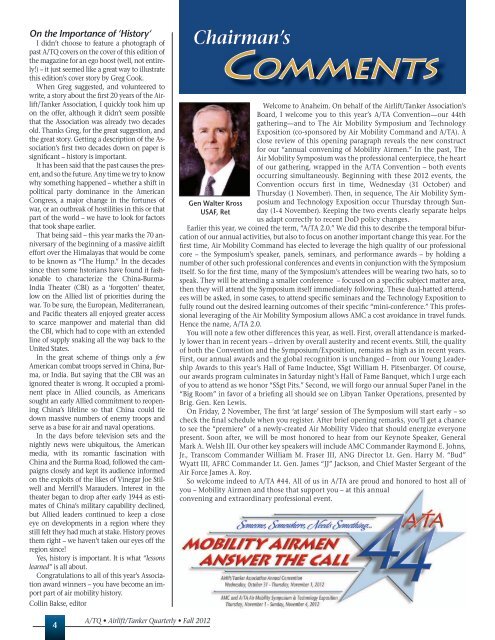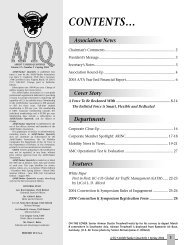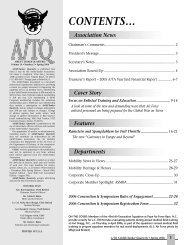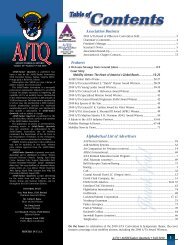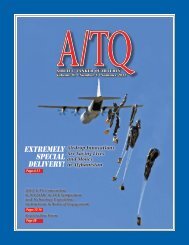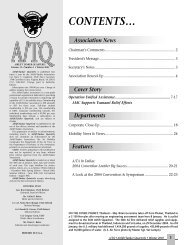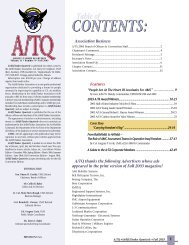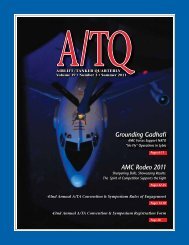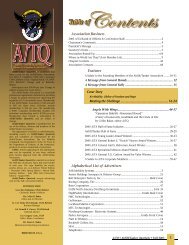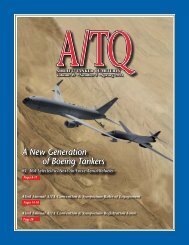A/TQ covers - Airlift/Tanker Association
A/TQ covers - Airlift/Tanker Association
A/TQ covers - Airlift/Tanker Association
You also want an ePaper? Increase the reach of your titles
YUMPU automatically turns print PDFs into web optimized ePapers that Google loves.
On the Importance of ‘History‘<br />
I didn’t choose to feature a photograph of<br />
past A/<strong>TQ</strong> <strong>covers</strong> on the cover of this edition of<br />
the magazine for an ego boost (well, not entirely!)<br />
– it just seemed like a great way to illustrate<br />
this edition’s cover story by Greg Cook.<br />
When Greg suggested, and volunteered to<br />
write, a story about the first 20 years of the <strong>Airlift</strong>/<strong>Tanker</strong><br />
<strong>Association</strong>, I quickly took him up<br />
on the offer, although it didn’t seem possible<br />
that the <strong>Association</strong> was already two decades<br />
old. Thanks Greg, for the great suggestion, and<br />
the great story. Getting a description of the <strong>Association</strong>’s<br />
first two decades down on paper is<br />
significant – history is important.<br />
It has been said that the past causes the present,<br />
and so the future. Any time we try to know<br />
why something happened – whether a shift in<br />
political party dominance in the American<br />
Congress, a major change in the fortunes of<br />
war, or an outbreak of hostilities in this or that<br />
part of the world – we have to look for factors<br />
that took shape earlier.<br />
That being said – this year marks the 70 anniversary<br />
of the beginning of a massive airlift<br />
effort over the Himalayas that would be come<br />
to be known as “The Hump.” In the decades<br />
since then some hstorians have found it fashionable<br />
to characterize the China-Burma-<br />
India Theater (CBI) as a ‘forgotten’ theater,<br />
low on the Allied list of priorities during the<br />
war. To be sure, the European, Mediterranean,<br />
and Pacific theaters all enjoyed greater access<br />
to scarce manpower and material than did<br />
the CBI, which had to cope with an extended<br />
line of supply snaking all the way back to the<br />
United States.<br />
In the great scheme of things only a few<br />
American combat troops served in China, Burma,<br />
or India. But saying that the CBI was an<br />
ignored theater is wrong. It occupied a prominent<br />
place in Allied councils, as Americans<br />
sought an early Allied commitment to reopening<br />
China’s lifeline so that China could tie<br />
down massive numbers of enemy troops and<br />
serve as a base for air and naval operations.<br />
In the days before television sets and the<br />
nightly news were ubiquitous, the American<br />
media, with its romantic fascination with<br />
China and the Burma Road, followed the campaigns<br />
closely and kept its audience informed<br />
on the exploits of the likes of Vinegar Joe Stilwell<br />
and Merrill’s Marauders. Interest in the<br />
theater began to drop after early 1944 as estimates<br />
of China’s military capability declined,<br />
but Allied leaders continued to keep a close<br />
eye on developments in a region where they<br />
still felt they had much at stake. History proves<br />
them right – we haven’t taken our eyes off the<br />
region since!<br />
Yes, history is important. It is what “lessons<br />
learned” is all about.<br />
Congratulations to all of this year’s <strong>Association</strong><br />
award winners – you have become an import<br />
part of air mobility history.<br />
Collin Bakse, editor<br />
Chairman’s<br />
Comments<br />
Gen Walter Kross<br />
USAF, Ret<br />
Welcome to Anaheim. On behalf of the <strong>Airlift</strong>/<strong>Tanker</strong> <strong>Association</strong>’s<br />
Board, I welcome you to this year’s A/TA Convention—our 44th<br />
gathering—and to The Air Mobility Symposium and Technology<br />
Exposition (co-sponsored by Air Mobility Command and A/TA). A<br />
close review of this opening paragraph reveals the new construct<br />
for our “annual convening of Mobility Airmen.” In the past, The<br />
Air Mobility Symposium was the professional centerpiece, the heart<br />
of our gathering, wrapped in the A/TA Convention – both events<br />
occurring simultaneously. Beginning with these 2012 events, the<br />
Convention occurs first in time, Wednesday (31 October) and<br />
Thursday (1 November). Then, in sequence, The Air Mobility Symposium<br />
and Technology Exposition occur Thursday through Sunday<br />
(1-4 November). Keeping the two events clearly separate helps<br />
us adapt correctly to recent DoD policy changes.<br />
Earlier this year, we coined the term, “A/TA 2.0.” We did this to describe the temporal bifurcation<br />
of our annual activities, but also to focus on another important change this year. For the<br />
first time, Air Mobility Command has elected to leverage the high quality of our professional<br />
core – the Symposium’s speaker, panels, seminars, and performance awards – by holding a<br />
number of other such professional conferences and events in conjunction with the Symposium<br />
itself. So for the first time, many of the Symposium’s attendees will be wearing two hats, so to<br />
speak. They will be attending a smaller conference – focused on a specific subject matter area,<br />
then they will attend the Symposium itself immediately following. These dual-hatted attendees<br />
will be asked, in some cases, to attend specific seminars and the Technology Exposition to<br />
fully round out the desired learning outcomes of their specific “mini-conference.” This professional<br />
leveraging of the Air Mobility Symposium allows AMC a cost avoidance in travel funds.<br />
Hence the name, A/TA 2.0.<br />
You will note a few other differences this year, as well. First, overall attendance is markedly<br />
lower than in recent years – driven by overall austerity and recent events. Still, the quality<br />
of both the Convention and the Symposium/Exposition, remains as high as in recent years.<br />
First, our annual awards and the global recognition is unchanged – from our Young Leadership<br />
Awards to this year’s Hall of Fame Inductee, SSgt William H. Pitsenbarger. Of course,<br />
our awards program culminates in Saturday night’s Hall of Fame Banquet, which I urge each<br />
of you to attend as we honor “SSgt Pits.” Second, we will forgo our annual Super Panel in the<br />
“Big Room” in favor of a briefing all should see on Libyan <strong>Tanker</strong> Operations, presented by<br />
Brig. Gen. Ken Lewis.<br />
On Friday, 2 November, The first ‘at large’ session of The Symposium will start early – so<br />
check the final schedule when you register. After brief opening remarks, you’ll get a chance<br />
to see the “premiere” of a newly-created Air Mobility Video that should energize everyone<br />
present. Soon after, we will be most honored to hear from our Keynote Speaker, General<br />
Mark A. Welsh III. Our other key speakers will include AMC Commander Raymond E. Johns,<br />
Jr., Transcom Commander William M. Fraser III, ANG Director Lt. Gen. Harry M. “Bud”<br />
Wyatt III, AFRC Commander Lt. Gen. James “JJ” Jackson, and Chief Master Sergeant of the<br />
Air Force James A. Roy.<br />
So welcome indeed to A/TA #44. All of us in A/TA are proud and honored to host all of<br />
you – Mobility Airmen and those that support you – at this annual<br />
convening and extraordinary professional event.<br />
4<br />
A/<strong>TQ</strong> • <strong>Airlift</strong>/<strong>Tanker</strong> Quarterly • Fall 2012


